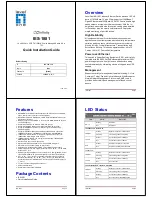
VLANs 38
Viewing and configuring PVIDs
You can view PVIDs from the following AOS CLI commands:
Port information
>> /info/port
Port Tag RMON PVID NAME VLAN(s)
---- --- ---- ---- -------------- -------------------------------
1 n d 1 Downlink1 1
2 n e 1 Downlink2 1
3 n d 1 Downlink3 1
4 n d 1 Downlink4 1
5 n d 1 Downlink5 1
6 n d 1 Downlink6 1
7 n d 1 Downlink7 1
:
:
Port configuration
>> /cfg/port 22/pvid 22
Current port VLAN ID: 1
New pending port VLAN ID: 22
>> Port 22#
Each port on the switch can belong to one or more VLANs, and each VLAN can have any number of switch ports in
its membership. Any port that belongs to multiple VLANs, however, must have VLAN tagging enabled. See the
“VLAN tagging” section in this chapter.
Any untagged frames (those with no VLAN specified) are classified with the PVID of the sending port.
VLAN tagging
The switch supports IEEE 802.1Q VLAN tagging, providing standards-based VLAN support for Ethernet systems.
Tagging places the VLAN identifier in the frame header, allowing each port to belong to multiple VLANs. When you
configure multiple VLANs on a port, you must also enable tagging on that port.
Since tagging fundamentally changes the format of frames transmitted on a tagged port, you must carefully plan
network designs to prevent tagged frames from being transmitted to devices that do not support 802.1Q VLAN tags,
or devices where tagging is not enabled.
Important terms used with the 802.1Q tagging feature are:
•
VLAN identifier (VID) — the 12-bit portion of the VLAN tag in the frame header that identifies an explicit VLAN.
•
Port VLAN identifier (PVID) — a classification mechanism that associates a port with a specific VLAN. For
example, a port with a PVID of 3 (PVID =3) assigns all untagged frames received on this port to VLAN 3.
•
Tagged frame — a frame that carries VLAN tagging information in the header. The VLAN tagging information
is a 32-bit field (VLAN tag) in the frame header that identifies the frame as belonging to a specific VLAN.
Untagged frames are marked (tagged) with this classification as they leave the switch through a port that is
configured as a tagged port.
•
Untagged frame — a frame that does not carry any VLAN tagging information in the frame header.
•
Untagged member — a port that has been configured as an untagged member of a specific VLAN. When an
untagged frame exits the switch through an untagged member port, the frame header remains unchanged.
When a tagged frame exits the switch through an untagged member port, the tag is stripped and the tagged
frame is changed to an untagged frame.
•
Tagged member — a port that has been configured as a tagged member of a specific VLAN. When an
untagged frame exits the switch through a tagged member port, the frame header is modified to include the
32-bit tag associated with the PVID. When a tagged frame exits the switch through a tagged member port, the
frame header remains unchanged (original VID remains).
NOTE: If an 802.1Q tagged frame is sent to a port that has VLAN-tagging disabled, then the frames are
forwarded based on their port-VLAN ID (PVID).
















































